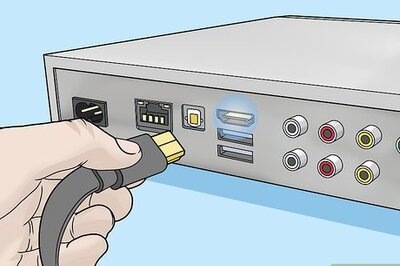
views
New Delhi: India's economy grew by a better than estimated 7.4 per cent in 2009-10 on the back of double digit expansion in manufacturing sector and not so dismal showing by farm sector.
In fact, the economy grew by a robust 8.6 per cent in the fourth quarter, fuelled by 16.3 per cent expansion in manufacturing sector.
China, the only large country with higher growth rate than India, witnessed 11.9 per cent growth in the same quarter, while the fragile recovery in most countries, particularly Europe, is under threat from a sovereign debt crisis.
Earlier, the Central Statistical Organisation had estimated the Indian economy to grow by 7.2 per cent for 2009-10.
The economic growth had slowed down to 6.7 per cent in 2008-09 after nine per cent expansion in the previous three fiscal years, as the economy came under the impact of global financial meltdown in 2008.
The 7.4 per cent growth clearly showed that stimulus provided by the government through excise duty and service tax cuts have yielded results, as the manufacturing which bore the brunt of the slowdown, posted 10.8 per cent growth in 2009-10 against 3.2 per cent a year ago.
Bolstered by the growth numbers, Finance Minister Pranab Mukherjee pegged the economic growth for this fiscal at over 8.5 per cent.
"... on the whole it is 7.2 per cent plus (in 2009-10). I have already stated 8.5 per cent, about 8.5 per cent plus (for the current fiscal)," he told reporters.
Stock markets reacted positively after GDP data came, but profit taking pulled down the equity benchmark index Sensex by around 10 points.
In fact, partial roll back of stimulus in this fiscal's budget significantly slowed down the growth of community, social and personal services to 5.6 per cent against earlier estimates of 8.2 per cent.
"...since the stimulus has been partially rolled back it also indicates the decline in community and personal and social services etc," Finance Secretary Ashok Chawla said.
Agriculture, which was hit by weak monsoon last year, did not fare as badly as was forecast earlier.
Farm and allied sectors grew by 0.2 per cent in 2009-10, whereas they were shown to decline by 0.2 per cent by advance estimates of the CSO earlier.
The sector posted negative growth of 1.8 per cent in the third quarter of 2009-10 against decline of 1.4 per cent a year ago. In the fourth quarter also, farm sector posted just 0.7 per cent growth against 3.3 per cent a year ago.
The economy is still primarily dependent on government stimulus as data shows private final consumption expenditure fell to 57.3 per cent in 2009-10 from 57.7 per cent a year ago.
The government's final consumption expenditure, however, was up 12.3 per cent from 11.7 per cent.
The government has already initiated the process of rolling back the stimulus. It raised excise duty on all non-petroleum goods by two per cent to 10 per cent in the Budget.
Gross fixed capital formation, which reflects value addition in the economy or capital that is invested rather than saved, also fell to 32.4 per cent from 33 per cent.
Besides manufacturing, mining and quarrying expanded by double digits--10.6 per cent in 2009-10, better than the advance estimates that had pegged it at 8.7 per cent.
Among services, trade, hotels, transport and communication rose by 9.3 per cent against advance estimates of 8.3 per cent.
However, community, social and personal services category, electricity, gas and water supply as well as financing, insurance, real estate and business services showed downward revision compared to advance estimates.
Although CSO estimates put electricity, gas and water supply growth to 8.2 per cent, the final figures showed a growth of only 6.5 per cent. Financing and the insurance sector grew by 9.7 per cent against CSO estimates of 9.9 per cent.
The growth numbers of all the previous three quarters has also been revised. While the second quarter saw growth at 8.6 per cent against provisional estimates of 7.9 per cent, third quarter GDP rose by 6.5 per cent against six per cent.
The first quarter GDP, however, was revised downwards to 6 per cent against 6.1 per cent estimated provisionally.
Explaining the rationale of revising quarterly figures, Chief Statistician Pronab Sen said, "Normally we do not change quarterly figure, unless the annual figure firms up. This time it was done because we changed base year to 2004-05 from 1999-2000 earlier."
The base year for calculating national income was revised from the third quarter onwards.
India Inc has cautioned the RBI against signalling a hike in interest rates on the basis of growth numbers in 2009-10 as it may impede future growth.
"Hiking of interest rates at this point in time will act as a break on the overall growth process," Ficci President Rajan Bharti Mittal said.
Global financial firm Barclays Capital said containing inflation is likely to remain the key policy priority of the RBI and the central bank may hike short-term rates by 25 basis points.
The Bombay Stock Exchange welcomed the GDP figures and ended the day 81 points up.
The country's chief statistician Pronab Sen said so far as GDP in 2010-11 is concerned, the figures for 2009-10 would not make any material difference as the European situation is a new phenomenon.
The finance secretary Ashok Chawla, however, pegged FY11 economic growth at 8.5 per cent. But he added that the growth numbers are pleasant but not surprising.
"The growth numbers are pleasant but not really surprising, because we were expecting them to be robust which they turned out to be. This clearly indicates the momentum which is in the economy and the expectations that the 8.5-percentage points estimation for 2010-11 is going to be a clear possibility," he said.
Others pegged the numbers a bit downwards at about 8 per cent for the current fiscal. Crisil chief economist DK Joshi pegged FY11 GDP at 8 per cent, while Standard Chartered Bank head of India research Samiran Chakraborty projected it to be 8.1 per cent.
Prime Minister's Economic Advisory Council chairman C Rangarajan exuded confidence that growth would likely to be 8.5 per cent. "I think growth rate will be 8-8.5 per cent. But I am closer to 8.5 per cent," he said.
Road and highways minister Kamal Nath said 10 per cent GDP growth is required and it has to be inclusive growth. This growth is going to impact all the states, he added.
The economic growth is quite striking given the fact that the OECD bloc, which accounts for over 60 per cent of the world economic output, expanded by just 0.7 per cent in the January-March quarter.
The country's per capita income stood at Rs 44,345 in 2009-10, more or less similar to what was estimated by the CSO earlier. It was higher by 10.5 per cent over Rs 40,141 a year ago. The economy has been valued at Rs 62.31 lakh crore for 2009-10.



















Comments
0 comment